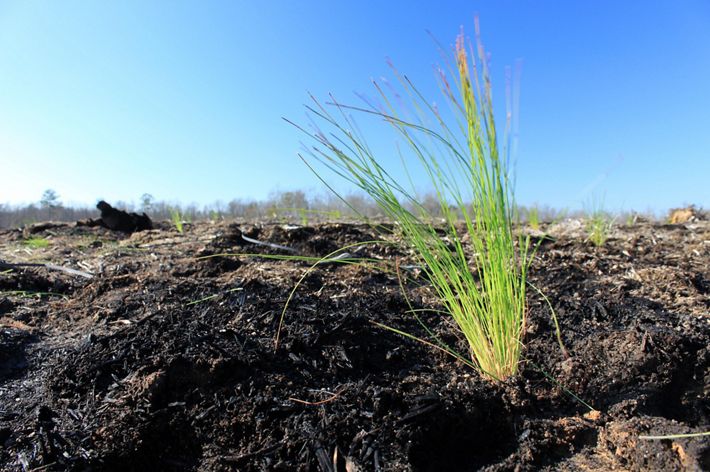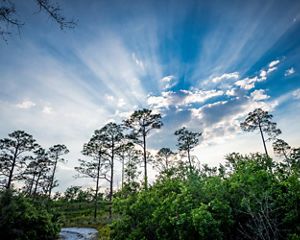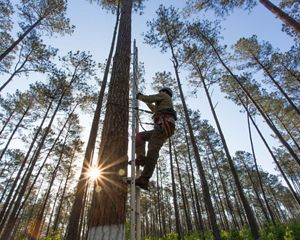Virginia Pinelands Program
Protecting centuries-old cypress swamps, the state's rarest bird and iconic longleaf savannas.
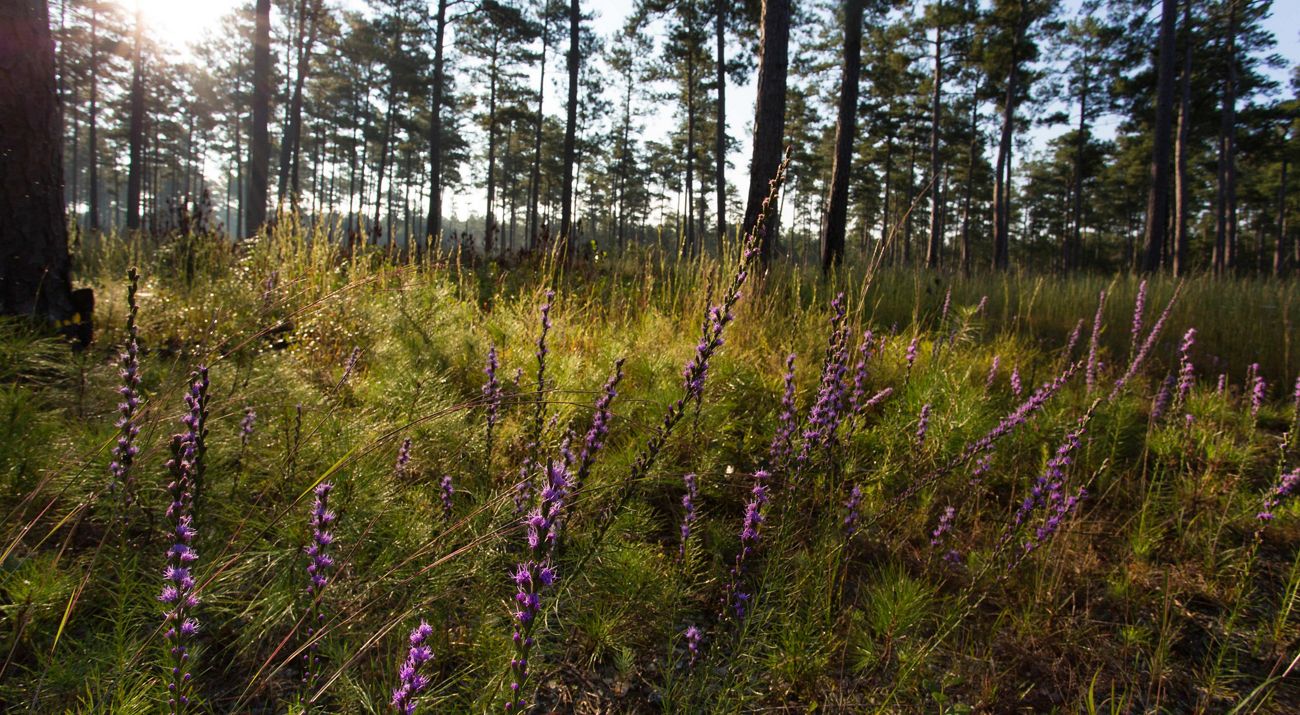
Through creative partnerships, land acquisition, ecological management and other conservation strategies, Virginia's Pinelands Program works to protect vast expanses of wetlands and rare forests in southeast Virginia that are home to centuries-old cypress swamps and rare longleaf pine savannas.
Longleaf Pine: A Forest Icon
Despite its proximity to a major metropolitan area, Virginia's Pinelands support an exceptional array of over 100 rare plants, animals and natural communities.
At Piney Grove Preserve we're working to restore the commonwealth's iconic longleaf pine savannas and the northernmost population of the red-cockaded woodpecker, a bird once in danger of extirpation in Virginia.
The story of longleaf pine (Pinus palustris) in Virginia spans many eras. Pollen dating, or palynology, records a climate-driven transition from boreal forest to pine savanna. This was followed by several thousand years of Indigenous stewardship, as native communities used fire to shape the landscape.
More than 1 million acres of longleaf forest extended south from the James River when English settlers arrived in 1607. The trees were the backbone of colonial America’s naval stores, providing masts, waterproof pitch and turpentine—much of it produced through the labor of enslaved individuals.
This sprawling longleaf forest was harvested to near extinction by 1893. A census conducted in 1998 revealed that just 200 mature native trees remained in Virginia.
A new era of restoration is turning the tide and rewriting the story of longleaf pine in Virginia.
An Era of Restoration
The Nature Conservancy purchased a 2,700-acre tract of pineland in Sussex County, Virginia from the Hancock Timber Resource Group in 1998 to create Piney Grove Preserve.
Our mission was to restore the property to a pine savanna, showcasing the remarkable biological diversity of southeastern Virginia’s longleaf forests.
Since our first purchase, we’ve expanded the preserve and adjacent public lands to more than 10,000 acres in partnership with the commonwealth
Longleaf pine trees vanished from Piney Grove and adjacent lands many years ago, but guided by science, TNC and partners are gradually restoring the tree to its former prominence. This effort involves selectively harvesting patches of the existing forest—primarily loblolly pine—to create forest openings suitable for planted longleaf seedlings to grow.
Life Cycle of the Longleaf
As a seedling, longleaf looks more like a clump of grass than the slender, towering tree it will become. This grass stage can last from one year to a dozen, depending on competition for resources with other plants.
The young longleaf isn’t very impressive above ground, but makes up for its lack of height by putting down a massive root system. Energy stored below ground and lush thick needles help the seedling survive fire events.
At the bottlebrush stage, the tree grows three to four feet straight up with no branches. After a few years, branches emerge and a sapling is born. After 30 years, the longleaf is finally ready to reproduce, dropping huge pine cones and the cycle begins anew.
Restoring Longleaf
Guided by science, TNC and partners are gradually restoring longleaf to its former prominence.
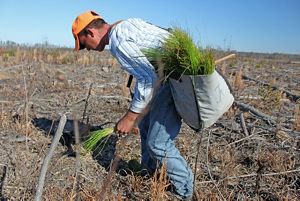
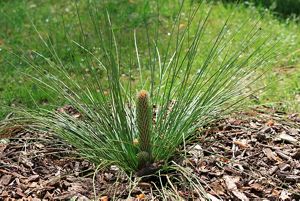
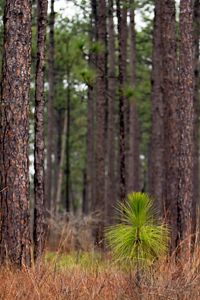
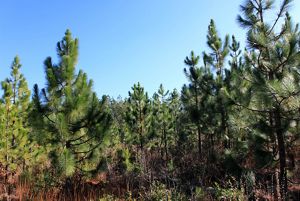
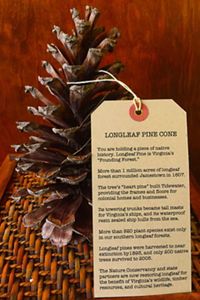

Planting Longleaf: Longleaf seedlings being planted at Raccoon Creek Pinelands, Virginia. © Daniel White/ TNC

Grass Stage: During the grass stage, longleaf seedlings are virtually immune to fire. Longleaf pine grove planted at the Mariners’ Museum and Park in Newport News, Virginia. © Daniel White / TNC

Bottle Brush Stage: After using its energy to sink a deep root system during the grass stage, the longleaf seedling begins growing up during the bottle brush stage. © Erika Nortemann / TNC

Sapling Stage: A stand of longleaf saplings at Raccoon Creek Pinelands, Virginia. © Daniel White / TNC

A Piece of Virginia History: Sharing the story of Virginia's founding forest. © Whitney Hall / TNC
Home Grown
As restoration efforts gained momentum in the early 2000s, preserving the unique genetics of Virginia's remaining native longleafs became a priority. Seeds were collected in Virginia and grown in North Carolina, which has well-established longleaf pine nursery capacity. In 2017, the Virginia Department of Forestry installed equipment at their Garland Gray Nursery to enable the process to be completed in-state.
The longleaf trees we plant at Piney Grove are grown from seeds of native Virginia trees for optimal seedling survival and growth. We also conduct plantings in close partnership with Virginia’s departments of Conservation and Recreation, Forestry and Wildlife Resources to restore longleaf on the state’s public lands.
Private landowners like TNC partner Bill Owen have hosted some of the largest planting projects in Virginia. Since 2003, Owen has worked with TNC and our partners to plant more than 1,500 acres of longleaf on his property in the Raccoon Creek Pinelands project area. In addition, Owen has placed his entire 1,850-acre property under conservation easement with TNC to ensure it will always be managed for its ecological diversity.
Virginia's Rarest Bird
Longleaf forests are among the world’s most biologically diverse, home to hundreds of species of birds and 920 plant species found nowhere else on Earth.
The signature creature of Southern pine forests is the red-cockaded woodpecker (RCW); Piney Grove harbors one of the northernmost breeding populations in the U.S. Listed as endangered in 1970, this bird nests exclusively in live pines and requires mature trees with soft heartwood for excavating nest cavities.
Red-cockaded woodpeckers once numbered in the hundreds of thousands across the Southeast and up into New Jersey, but the loss of old-growth pine habitat led to a dramatic decline.
Beginning in 2001, woodpeckers captured from stable populations in the Carolinas were released at Piney Grove to boost the number of breeding colonies.
Biologists from the Center for Conservation Biology have documented modern-day highs at Piney Grove for the numbers of breeding pairs and fledglings. Approximately 70 red-cockaded woodpeckers now call Piney Grove home.
In 2019, Piney Grove's woodpeckers reached another milestone. In only sixteen years, the population has grown large enough—and stable enough—to help support a new colony at Great Dismal Swamp National Wildlife Refuge.
A single pair of hatch-year birds, including a male and female, were moved from Piney Grove to Great Dismal during the falls of 2017, 2018 and 2019. In September 2020, TNC and partners translocated two pairs of woodpeckers, bringing the total transfer to ten individuals to date.
Intensive habitat management by Virginia's Department of Wildlife Resources at neighboring Big Woods Wildlife Management Area has also been paying dividends for RCW recovery.
In 2017, DWR and TNC biologists discovered a banded male RCW with an active cavity on Big Woods WMA; the bird had originated from the Piney Grove population. This was the first documented occurrence of an individual or cavity on the WMA, demonstrating that DWR’s restoration efforts were making a difference and Piney Grove’s woodpeckers were finding the expanded habitat they need—even ahead of the timeline DWR biologists expected. By January 2023, it’s estimated that between five and seven RCWs are using the Big Woods habitat.
Taken together, these milestones in the recovery of this species in Virginia is a sign that investment in aggressive management during the early 2000s is paying off.
Returning Fire, Returning Forest
Open pine savannas, especially longleaf, evolved naturally over many centuries as lightning strikes and Native American burning made fire a regular part of the landscape. With support from numerous partners, TNC has worked since 1999 to return fire to Piney Grove.
Our fire team carefully plans and conducts prescribed burns across the preserve, revisiting previously burned areas every two to four years to mimic the historic frequency of fire. Many native plant species depend on fire to reveal bare mineral soil, stimulate seed germination and reduce competition from shrubs and faster-growing tree species. Planted longleaf seedlings on the preserve thrive after being burned.
In 2017, nearly 40 fire team members from TNC and an alphabet soup of agencies collaborated to undertake what, at the time, was the largest controlled burn ever ignited at Piney Grove. Fire crews on the ground and in the sky successfully burned more than 1,800 acres owned by both TNC and the state of Virginia. Participating partners included the Virginia departments of Conservation and Recreation (Natural Heritage Program), Wildlife Resources and Forestry, as well as the U.S. Fish and Wildlife Service and a team of young AmeriCorps volunteers.
Resuming large scale fire after the Pandemic, the 2017 Piney Grove burn was surpassed in 2021 with a record-setting 2,500-acre effort that included a relatively new fire partner, DCR State Parks.
In 2022 Piney Grove played host to WTREX—Women-in-Fire Training Exchange—bringing together people of all genders from TNC and similar organizations, state and federal agencies, tribes and universities. Ranging from rookie firefighters to experienced burn managers, the participants engaged in 10 days of intensive workshop and field experiences aimed at supporting and retaining female fire professionals.
Land Protection: The Great Dismal
TNC brokered the nation’s first major corporate donation of conservation land in 1973. The following year, Union Camp Corporation's gift of nearly 50,000 acres established Great Dismal Swamp National Wildlife Refuge, which today encompasses more than 110,000 acres.
Due to a history dating back to George Washington of ditching and draining, the swamp's hydrology—its plumbing—is out of balance. While fire is a natural disturbance among the swamp’s ecological processes, a swamp that’s too dry becomes more susceptible to damaging wildfires.
TNC works with the U.S. Fish and Wildlife Service to reduce the threat of these intense fires. Acting as “nature’s plumber,” we’re seeking to manage the water flow, mimic seasonal flooding and re-wet the swamp. This project involves installing and maintaining several water control systems across the refuge. We’re not going to stop wildfires in the swamp, but we can reduce their intensity to make the refuge healthier for wildlife and safer for communities.
Conservation at Work
- Good Fire: Using science-based methods, TNC partners with state and federal agencies to return fire to the landscape. In 2017 we successfully conducted the largest ever controlled burn at the 2,700-acre Piney Grove Preserve.
- Restoring Habitat: We collaborate with partners at the College of William & Mary’s Center for Conservation Biology, as well as state and federal agencies, to monitor the population red-cockaded woodpecker populations at Piney Grove Preserve and Great Dismal Swamp NWR.
- Land Management: We work with private landowners to restore globally rare pine savanna habitat. Through the Virginia Aquatic Resources Trust Fund, we are restoring forested wetlands to establish strategically located wildlife corridors.
- Conservation Easements: A conservation easement is a legal agreement, recorded with the deed, that restricts the type and amount of development that can take place on the land. TNC works with private landowners to secure easements along river corridors, protecting water quality and riparian habitat. TNC served on an advisory board encouraging the City of Chesapeake to enact a new purchase of development rights program to protect open space. The city purchases development rights from willing private landowners, who then retain ownership while permanently keeping their lands as open space or in agricultural use.
- Education and Outreach: We foster a conservation ethic and appreciation for nature through education and outreach. TNC works to influence land-use planning and is helping local communities learn about development approaches that preserve local character, history, traditions and, ultimately, the ecosystem itself.
- Shaping Public Policy: TNC is a member of Virginiaforever, a campaign to garner increased public support and state funding for conservation.
Contact
Brian van Eerden
Program Director
email: bvaneerden@tnc.org

We Can’t Save Nature Without You
Sign up to receive monthly conservation news and updates from Virginia. Get a preview of Virginia's Nature News email

